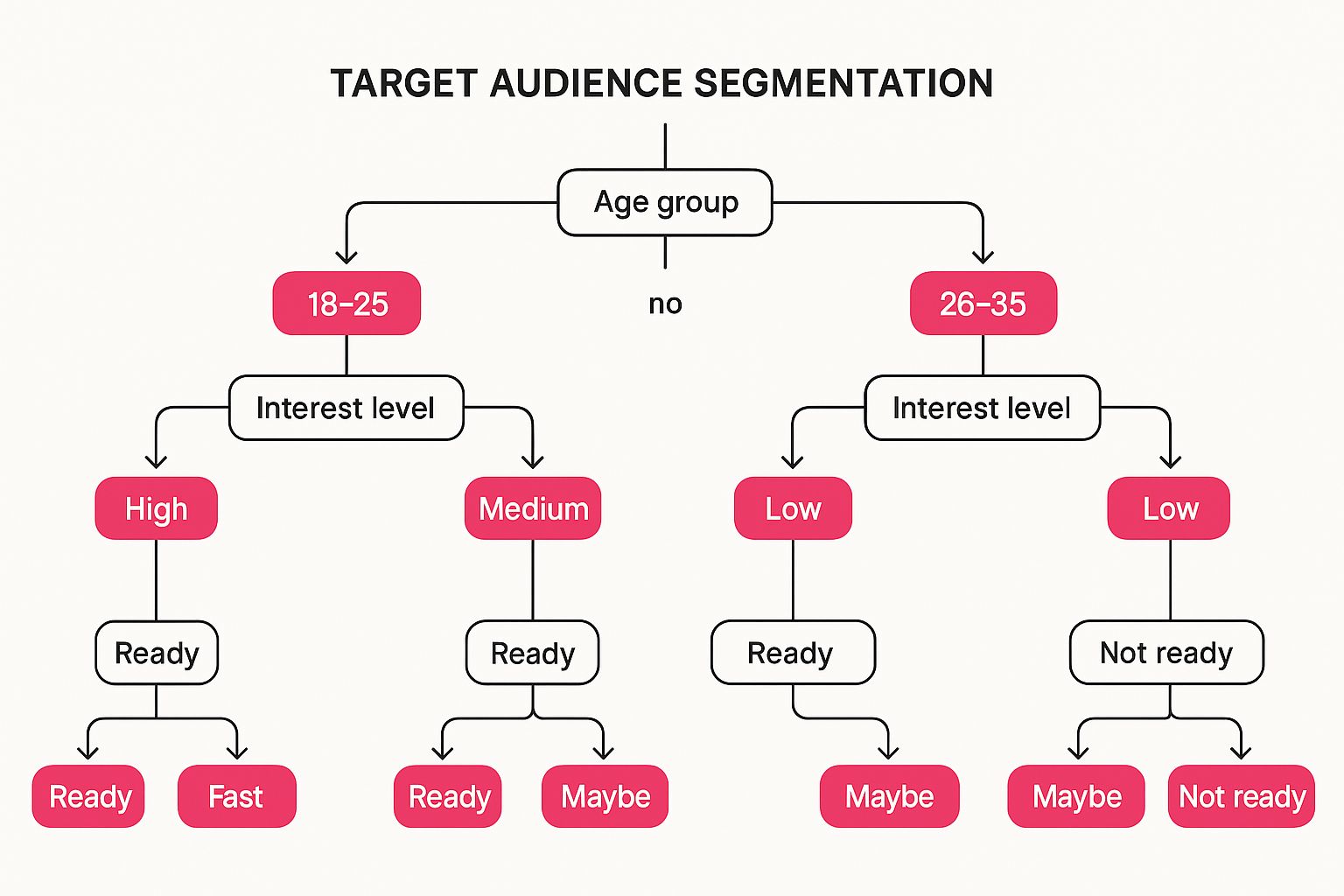A strong startup marketing plan isn't just a document; it's your roadmap to growth. It’s the playbook that details exactly how you'll find, connect with, and ultimately win over your target customers. Think of it as the critical link that translates your big business goals into actionable marketing tasks.
Build Your Foundation Before You Spend a Dirham

As a founder, the urge to jump straight into running flashy ads is powerful. I get it. But the startups that actually make it are the ones that build their house on a rock-solid foundation first. Before you spend a single dirham on paid campaigns, the time you dedicate to foundational research will be the most valuable investment you make. This early work is what separates a smart, informed strategy from expensive guesswork.
This isn’t about just filling out a template. It's about developing a genuine, almost obsessive, understanding of the market you want to serve. It's the difference between shouting into a crowded room and having a meaningful conversation with the few people who are actively searching for what you’ve built.
Uncover What Customers Actually Want
Your first job isn't to be an expert on your product's features—it's to become an expert on your customers' problems. Real market research goes far deeper than a simple survey. You're on a mission to uncover the unspoken needs and deep-seated frustrations of your audience.
- Talk to people. Seriously, get on the phone or grab coffee with at least 10-15 potential customers. Ask open-ended questions about their biggest headaches, the workarounds they've tried, and what a "magic wand" solution would look like.
- Become a digital anthropologist. Dive into the Reddit threads, industry forums, and private Facebook groups where your audience lives. Pay close attention to the exact language and phrases they use to describe their pain points. These are pure gold for your future marketing messages.
- Use the "Jobs to Be Done" framework. Don't ask what product they want; ask what "job" they're trying to accomplish. No one buys a drill because they want a drill; they buy it because they want to hang a picture. What's the real outcome your customer is after?
So many startups make the classic mistake of building a solution and then desperately searching for a problem it can solve. Real marketing starts by finding a painful, existing problem and then positioning your product as the only logical solution.
This groundwork will inform every single part of your marketing plan, from the words on your homepage to the targeting of your first ad campaign.
Craft Detailed and Actionable Buyer Personas
Once you've collected all that raw intel, it's time to bring your ideal customer to life by creating detailed buyer personas. A persona is a semi-fictional character profile that represents your perfect customer. It’s how you turn a vague audience segment into a tangible person you can speak to directly.
Please, go beyond basic demographics like age and location. A truly useful persona digs into what makes them tick:
- Goals & Motivations: What are they trying to accomplish in their career or life?
- Challenges & Pain Points: What specific obstacles are holding them back?
- Watering Holes: Where do they get their information? Think specific blogs, podcasts, influencers, and social channels.
- Real Quotes: Pull direct quotes from your interviews to capture their authentic voice and concerns.
For example, "Male, 30-40, works in tech" is useless. But "Tech Lead Tariq," who is struggling to keep his remote team productive and secretly worries about missing deadlines, is someone you can market to. This level of detail helps you create content and ads that speak directly to Tariq's very real anxieties and ambitions.
Analyze Your Competitors to Find an Opening
Finally, you have to know who you’re sharing the field with. A competitive analysis isn't about copying what others are doing. It's about finding the gaps in their strategy—the openings they've left for you.
The startup scene in the UAE and the wider MENA region is buzzing with energy and investor confidence, with companies raising a staggering $3.94 billion in 2023. Much of that capital is being pumped into marketing, especially in hot sectors like fintech and AI. This means your competitors are likely well-funded and smart. You can explore more about Middle Eastern startup funding to get a clearer picture of this competitive landscape.
Choose Your Marketing Channels With Confidence
Once you’ve done your research, the big temptation is to jump in and start shouting your message from every rooftop. My advice? Don't. A scattergun approach, where you throw your precious budget at every trendy platform, is the fastest way to burn through cash with absolutely nothing to show for it. The real goal isn't to be everywhere; it's to be where it actually matters.
Choosing the right marketing channels for your startup is less about what’s hot right now and more about finding a strategic fit between your platform, your product, and your people. The channels that work wonders for a D2C e-commerce brand selling sustainable fashion will look completely different from those for a B2B SaaS startup chasing enterprise clients.
Match Channels to Your Customer’s Behaviour
Think of your buyer personas as your treasure map. Where do these people "live" online? You can't just guess. Your initial research should have given you a solid idea of the specific blogs they read, the influencers they trust, and the social media platforms they scroll through when they’re supposed to be working.
-
B2B SaaS Startup: Let's say your persona is "Tech Lead Tariq." He likely spends his professional time on LinkedIn, follows niche industry publications, and might even be active in subreddits dedicated to his specific tech stack. This immediately points you toward LinkedIn advertising, highly-targeted content marketing, and maybe even some good old-fashioned direct outreach.
-
D2C E-commerce Brand: Your "Eco-conscious Aisha" persona probably discovers new products on Instagram and TikTok. She follows sustainability influencers and actually opens emails from brands she trusts. This tells you to focus heavily on visual social media, build influencer partnerships, and cultivate a rock-solid email list.
Framing it this way cuts through the noise and helps you turn an overwhelming list of options into a short, manageable, and logical one.
Weigh Effort Against Potential Impact
Every channel is different. They demand varying amounts of time and money and deliver results on completely different timelines. From my experience, the most resilient startup marketing plans have a healthy mix of both short-term wins and long-term plays.
This decision tree helps visualize how you might segment your audience to better guide your channel selection.

As the visual shows, an audience with high interest that's ready to buy needs a very different channel strategy than one that's just starting to get curious.
My Two Cents: Start with one or two core channels where you feel most confident you'll find your ideal customer. Get really, really good at them before you even think about expanding. Going an inch deep and a mile wide is a classic startup mistake and a recipe for failure.
Content marketing and SEO, for instance, are the definition of a long game. They build a valuable, lasting asset for your company, but it could easily take 6-12 months to see significant organic traffic. On the flip side, paid advertising on platforms like Google or Facebook can bring in leads almost instantly, but that traffic disappears the second you turn off the spend.
If you’re diving into social media, look for tools that can give you an edge. For a platform like Reddit, which is all about deep community engagement, something like a Reddit Post Generator can help you quickly craft posts that match the unique vibe of different subreddits.
A Framework for Making the Call
To make this decision process less of a guessing game, I like to use a simple framework. It forces you to think critically about how each potential channel stacks up against your specific business goals and resources.
Here’s a table that can help you organize your thoughts:
Marketing Channel Selection Framework
| Marketing Channel | Best For (Audience/Model) | Typical Cost | Time to See Results | Key Success Metric |
|---|---|---|---|---|
| SEO & Content | B2B, B2C with research-heavy buys | Medium (Time/Talent) | 6-12 Months | Organic Traffic, Keyword Rankings, Leads |
| Paid Social (Meta/TikTok) | D2C, B2C, some B2B (awareness) | Low to High (Ad Spend) | 1-7 Days | ROAS, Cost Per Acquisition (CPA) |
| Paid Search (Google Ads) | High-intent B2C & B2B | Medium to High (Ad Spend) | < 24 Hours | Click-Through Rate (CTR), Conversion Rate |
| Email Marketing | Customer retention, B2B & B2C | Low (Platform cost) | Immediate | Open Rate, Click-Through Rate, ROI |
| LinkedIn (Organic/Ads) | B2B, high-value services | Medium (Time/Ad Spend) | 1-30 Days | Lead Quality, Engagement Rate |
This isn't an exhaustive list, but it's a fantastic starting point. Run your top 3-5 channel ideas through this kind of analysis. It will quickly become clear where you should place your initial bets.
Align With Regional Trends
It’s crucial to know what’s happening on the ground where your customers are. For startups in the Middle East and Africa, particularly with the UAE as a hub, the digital advertising market is an absolute powerhouse, generating around $32 billion in revenue in 2024.
A huge driver of this is mobile advertising, which accounts for a staggering 55.36% of that revenue. This isn't just a statistic; it's a mandate. A mobile-first strategy isn't optional here—it's essential. Smart startups are crushing it on Instagram and Facebook with personalized campaigns that tap directly into the UAE’s incredibly high smartphone penetration.
This data screams that your channel choices must align with how people in your region behave, and right now, that behavior is overwhelmingly mobile.
Ultimately, your channel mix should be a living, breathing part of your marketing plan. Start small, measure everything, and be ruthless about doubling down on what works. And don't be afraid to kill a channel that isn't delivering, no matter how popular you think it is. Email marketing, for example, consistently delivers one of the highest ROIs, but its success hinges entirely on smart segmentation. To really nail this, check out these proven email marketing segmentation examples to learn how to target your messages effectively.
Set a Realistic Startup Marketing Budget
Alright, let's talk about money. For most founders, carving out a marketing budget feels like a shot in the dark—a mix of what you think you should spend and what you can actually afford. But it doesn't have to be a mystery. A well-thought-out budget is what turns your marketing plan from a document of ideas into a real, actionable engine for growth.
It's a balancing act. You have to be brutally honest about your current cash flow while still being ambitious enough to hit those critical early milestones. Without a financial roadmap, even the most brilliant marketing strategies will just sit on the shelf.
Choose a Budgeting Model That Fits Your Stage
There's no magic number or universal formula here. The right way to build your budget depends entirely on where your startup is in its lifecycle. Most founders start with one of two common models.
-
Percentage of Revenue: This is the go-to for businesses with predictable income. You simply dedicate a set percentage of your revenue to marketing. A more established company might allocate 5-10%. But for a startup in a high-growth phase? That number needs to be much, much bigger. Think 20-30% or even more if you're aggressively trying to capture market share.
-
Objective-and-Task Method: This is, hands down, the most practical approach for early-stage or pre-revenue startups. Instead of pulling a percentage out of thin air, you build your budget from the ground up. You start with a clear goal (e.g., "acquire 100 new trial users") and then list out every single cost associated with achieving it—the ad spend, the content creation, the software tools, everything.
For a company just getting off the ground, the objective-and-task method is far more effective. It forces you to think critically about every dollar and ties your spending directly to tangible results.
How to Allocate Your Funds Smartly
Once you’ve settled on a total budget, the real work begins: deciding where that money goes. A rookie mistake I see all the time is founders dumping their entire budget into flashy, short-term tactics like paid ads. They get a quick hit of traffic but completely ignore the foundational work that builds a brand for the long haul.
A smart budget balances immediate needs with future growth. You need leads today, but you also need to be building a brand that will still be attracting customers two years from now. Don't sacrifice the long game for a short-term sugar rush.
Think of your budget as an investment portfolio with different levels of risk and return horizons:
- Brand Building (The Long Game): Earmark a portion of your funds for channels like SEO and content marketing. These are slow burns—it can easily take six months or more to see significant traction. But the payoff is a sustainable, cost-effective asset that keeps bringing in customers for years.
- Lead Generation (The Quick Wins): Dedicate a chunk of your budget to activities that produce immediate results, like Google Ads or targeted social media campaigns. These are absolutely essential for hitting your early revenue goals and proving to investors (and yourself) that your model works.
- Essential Tools (Your Infrastructure): Never forget to budget for your MarTech stack. This includes your CRM, email marketing platform, and analytics software. These aren't flashy, but they are the operational backbone that makes modern marketing possible.
A well-balanced split might be something like 40% for lead generation, 40% for brand building, and 20% for your technology stack and overhead. This mix ensures you're both hunting for new business today and farming for your future pipeline.
Track Spending and Justify It to Stakeholders
Your budget isn’t a "set it and forget it" document. It’s a living thing. You have to track every single dollar and, more importantly, measure what it’s getting you. This is non-negotiable, especially when you have to answer to investors, your co-founder, or your board.
Get very comfortable with the term Customer Acquisition Cost (CAC). It’s a simple but powerful metric: your total marketing spend divided by the number of new customers you brought in. Knowing your CAC is the only way to tell if your marketing is actually profitable and if your growth is sustainable.
Keeping meticulous records and creating clear reports that directly link spending to results—like leads generated, new trial sign-ups, and actual revenue—is how you build trust. It’s how you prove you’re a responsible steward of the company's capital, which is exactly what you need to do to secure more marketing investment down the road.
Bring Your Plan to Life with the Right Tech Stack

A brilliant strategy is just a collection of good ideas until you have the right tools to make it happen. Modern marketing runs on technology, but the good news is you don't need a massive enterprise budget to get in the game. The real trick is building a lean, powerful MarTech stack that handles the repetitive work and scales with you.
The goal isn't to collect shiny new software. It's about finding affordable, high-impact tools that solve real problems, save you precious time, and deliver the data you need to make smarter moves. Let’s focus on the essentials that will become the engine of your startup marketing plan.
The Core Four Your Startup Needs
For most new businesses, you can cover your most critical bases with just four types of tools. Think of these as the foundational pillars of your entire marketing operation.
-
Customer Relationship Management (CRM): This is your command center. A CRM organizes every bit of customer and lead information in one place, tracking every interaction. It’s what stops valuable leads from falling through the cracks and gives you a single source of truth for all your customer data.
-
Email Marketing Platform: Email consistently delivers one of the best ROIs in marketing, period. A dedicated platform lets you build your subscriber list, slice and dice your audience into segments, and send targeted campaigns that actually nurture leads and keep customers coming back.
-
Social Media Management Tool: Trying to juggle multiple social media channels by hand is a recipe for burnout. A management tool lets you schedule posts ahead of time, listen in on conversations, and analyze performance from a single dashboard. This frees you up to think about strategy, not just posting.
-
Analytics Platform: You can't improve what you don't measure. An analytics tool, like Google Analytics, is absolutely non-negotiable for understanding how people find and interact with your website. It’s the only way to know what’s working and what’s a waste of money.
This focused approach to technology is more important than ever. The Middle East's MarTech market is on track to hit $8.29 billion in revenue in 2024, thanks to a huge push in digital adoption. For startups in the UAE, this boom means better access to advanced automation and analytics, making a data-driven strategy more achievable than ever before.
Use Automation to Punch Above Your Weight
For a lean team, automation isn't a "nice-to-have"—it's a survival tactic. It allows you to get the work of a much larger team done by handling all the boring, repetitive tasks. This frees you and your team up to focus on the creative, strategic work that actually grows the business.
And it's simpler than you think. Imagine a new lead fills out a form on your site. Without automation, you’d have to manually copy their info into your CRM, write a welcome email, and set a reminder to follow up. With a simple automated workflow, all of that happens instantly, even while you sleep.
Pro Tip: Start with one simple automation. A classic is a welcome email series. When someone joins your newsletter, have a sequence of 3-4 emails sent automatically over a week. You can introduce your brand, offer something valuable, and make a fantastic first impression at scale.
This is where your CRM and email platform really start to work together. You can find some fantastic marketing automation workflow examples that show you exactly how to connect your tools to create a smooth, seamless journey for your customers.
To make sure you're getting the most out of it, take a look at some key marketing automation best practices to get your operations humming.
How to Choose Your Tools Without Breaking the Bank
Picking out your tech stack is exciting, but it’s also easy to get carried away. The market is flooded with options, all claiming they'll change your business overnight. Here’s how to stay grounded and make smart choices.
A Lean MarTech Stack for Startups
| Tool Category | Free/Affordable Option | Why It's Great for Startups |
|---|---|---|
| CRM | HubSpot Free CRM, Zoho CRM | Manages up to 1 million contacts and tracks every deal without costing a dime to start. |
| Email Marketing | MailerLite, Brevo | Offers powerful automation features on free or cheap plans, perfect for your first campaigns. |
| Social Media | Buffer, Later | Their free tiers handle scheduling and basic analytics, saving you hours of manual posting each week. |
| Analytics | Google Analytics 4, Hotjar | Gives you all the essential website traffic and user behavior insights for free. |
My best advice? Always start with the free plan. Push it to its absolute limits before you even think about upgrading. This forces you to get crystal clear on what you actually need versus what's just a "nice-to-have" feature. A powerful tech stack for your startup marketing plan is built on solving real problems, not collecting the most software.
Measure Success and Adapt Your Strategy
Think of your startup's marketing plan not as a precious document to be framed, but as a well-worn map for a journey into the unknown. It’s a living guide, meant to be creased, marked up, and adapted to the messy reality of the market. The truth is, the moment you print it, it’s already becoming outdated. The real work—and the real magic—happens next. It's in the disciplined, almost obsessive act of measuring what’s working and being ruthless about cutting what isn’t.
This is exactly where I see so many founders stumble. It's easy to get hypnotized by vanity metrics—those flashy numbers that feel great but tell you almost nothing about your business's health. Social media likes, follower counts, even broad website traffic can be dangerously misleading. They’re an ego boost, not a business strategy. A smart marketing plan tunes out that noise and focuses with laser precision on the metrics that actually move the needle.
Focus on Metrics That Matter
If you want to build a sustainable business, you have to measure what directly impacts your bottom line. We call these your Key Performance Indicators, or KPIs. They’re the true north stars that should guide every single marketing decision you make.
Forget the fluff. At the start, you can get by with just these three heavy hitters:
-
Conversion Rates: Simply put, this is the percentage of people who do what you want them to do—sign up for a trial, download a resource, or buy your product. A high conversion rate is the ultimate validation that your message is hitting the mark with the right people.
-
Customer Lifetime Value (CLV): How much is a customer actually worth to you over their entire relationship with your startup? Knowing your CLV is critical because it tells you exactly how much you can responsibly spend to acquire a new customer and still be profitable.
-
Marketing-Attributed Revenue: This is the big one. It’s the metric that directly connects your marketing efforts to actual sales. It answers the question every founder and investor has: "Is the money we're spending on marketing bringing in more money?"
Your goal isn't to be busy; it's to be effective. Measuring these core KPIs is the only way to know the difference. It transforms marketing from a line item on your expense sheet into a predictable engine for revenue.
Making this shift—from vanity to value—is what separates the startups that hit escape velocity from those that fizzle out. It forces you to justify every dollar spent and every hour invested.
Build Your Mission Control Dashboard
You can't manage what you don't measure. But that doesn’t mean you need some complicated, enterprise-level analytics suite right out of the gate. The key is to build a simple, clear dashboard that gives you an at-a-glance view of your most critical numbers. This is your mission control.
Most of the tools you're already using—from Google Analytics to your email platform—have their own built-in analytics. The first step is to pull the most important KPIs from each source into a single place. Honestly, a well-organized spreadsheet works perfectly when you're starting out. This dashboard becomes your single source of truth for marketing performance.
To get a complete picture of how all your channels work together, you'll need a solid system for effective marketing campaign tracking. This is what helps you connect the dots between your efforts and the results.
The Art of the Agile Pivot
With your KPIs and dashboard in place, you can finally create a rhythm of review and adaptation. A static annual plan is a death sentence for a fast-moving startup. You have to be agile.
Here's a simple framework that works:
-
Weekly Check-in (15 Minutes): A quick scan of your dashboard. See any sudden spikes or dips? Is that one ad campaign burning through cash with zero conversions? This is your early warning system for putting out fires.
-
Monthly Review (1 Hour): Time for a deeper dive. Look for trends. Is your cost per lead creeping up? Is a particular blog topic driving way more sign-ups than others? This is where you make tactical adjustments.
-
Quarterly Overhaul (Half-Day): This is your big-picture strategy session. Based on the last three months of hard data, do you need to kill an entire channel? Should you double down on another? This is where you make major changes to your marketing plan.
For example, let's say you're running ads on both Google and LinkedIn. Your monthly review might show that LinkedIn is generating leads at three times the cost of Google. That data gives you the confidence to pause the expensive LinkedIn campaigns and reallocate that budget to what’s clearly working better.
As part of this ongoing review, it's also essential to learn how to measure SEO success and pay attention to its unique metrics. Organic growth is a long game, and it requires a different kind of patient analysis. This continuous loop—measure, learn, adapt—is what will keep your marketing sharp, efficient, and perfectly aligned with your business goals as you scale.
Got Questions About Your Startup Marketing Plan? Let's Clear Things Up.

Even with the best guide in hand, putting together your first marketing plan can feel like you're trying to solve a puzzle with half the pieces missing. It's totally normal for questions to bubble up once you start moving from theory to the real world. Getting bogged down by these common hurdles is the last thing you need when momentum is everything.
So, let's tackle those nagging questions head-on. Here are some straightforward answers to the things I see founders get stuck on most often, so you can get back to building your business with confidence.
How Much Should a Pre-Revenue Startup Even Spend on Marketing?
When there's no money coming in, the idea of a marketing budget can be downright terrifying. But here's the good news: for a pre-revenue startup, your biggest asset isn't cash. It's your time, your energy, and your creativity—what we often call "sweat equity."
Forget about trying to pin down a percentage. Your initial marketing spend is all about lean, strategic investments in learning, not blanketing the market with ads. Your focus should be on activities that have the highest impact for the lowest cost.
-
Nail the fundamentals first. Pour your energy into rock-solid market research, developing a brand identity that actually means something, and creating a few pieces of foundational content. Think of an SEO-optimized landing page and a couple of core blog posts that speak directly to your customer's biggest headaches.
-
Invest only in essential tools. A small, tightly controlled budget should cover the absolute must-haves. This could be a free or low-cost CRM to keep track of your first conversations or an affordable email marketing platform like MailerLite to start building that all-important email list.
-
Run tiny, targeted experiments. If you do spend cash, use a very small amount for focused ad experiments on a single channel. The goal here isn't to get hundreds of leads. It's to learn. You're testing your message and finding out if your assumptions about your audience were right.
At this stage, track every dirham. Your return on investment isn't measured in sales figures but in validated learnings: a message that resonates, a new email subscriber, or a crucial piece of feedback from a real user.
What's the Single Most Important Part of the Plan?
It's tempting to think every part of the plan is equally important, but if I had to pick one thing that makes or breaks everything else, it’s this: a deep, almost uncomfortably accurate understanding of your Ideal Customer Profile (ICP).
Seriously. Without knowing exactly who you're talking to—their hidden frustrations, their real goals, and where they actually hang out online—every other marketing activity is just a shot in the dark. Your messaging will feel generic, your channel choices will be random, and your content will land with a thud.
A well-defined ICP is the compass for all your marketing decisions. It tells you what words to use, which platforms to show up on, and what problems to promise you can solve.
Spending the extra time to get this right at the beginning will save you an incredible amount of wasted time and money later. It’s the difference between shouting into the void and having a meaningful conversation with the people who are most likely to become your first evangelists.
How Often Should I Be Updating This Thing?
Your marketing plan should never be a "set it and forget it" document that gathers digital dust in a forgotten folder. You have to treat it like a living, breathing guide that adapts as your business and the market change.
From my experience, the best rhythm involves two different cadences: a strategic reset and constant tactical monitoring.
Quarterly Strategic Review:
Once a quarter, block out time to formally review and update the entire plan. This is the sweet spot. It’s long enough to let your strategies play out and give you real data, but it’s frequent enough to pivot based on what you've learned and how the market has shifted.
Weekly Tactical Check-in:
On a weekly basis (at minimum), you need to have your eyes on your key performance indicators (KPIs). This is your early-warning system. Is a specific ad campaign suddenly burning through cash with no return? Did a new organic channel pop up out of nowhere and start sending you surprising traffic? You need to know now, not in three months.
This constant monitoring lets you make smart tactical adjustments on the fly without waiting for the next big quarterly review. Your plan sets the strategy, but your day-to-day vigilance provides the agility you need to survive and win. Don't let a "bad quarter" sneak up on you because you weren't watching the data.
Crafting a powerful startup marketing plan is the first crucial step, but turning that plan into real results requires expertise and relentless execution. At Grassroots Creative Agency, we specialize in transforming plans into measurable growth. We build data-supported, content-driven strategies that help Dubai-based startups thrive. Learn how we can build your growth engine.








